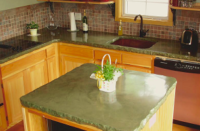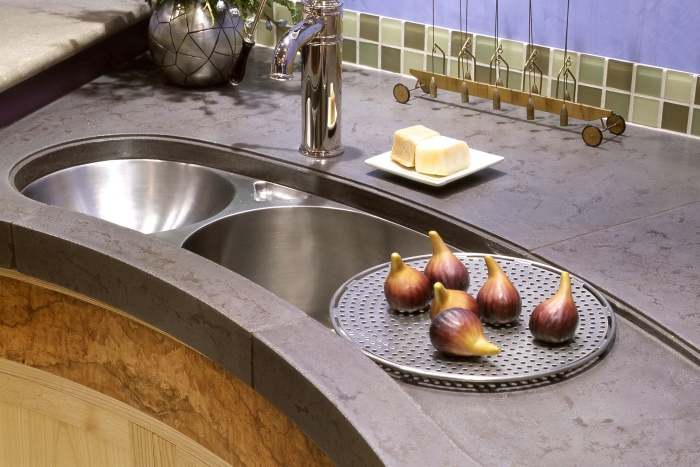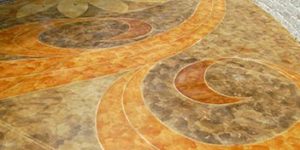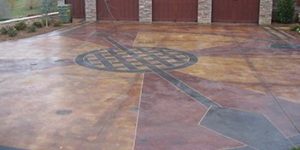Great concrete countertop design exists first in the designer’s creative mind. It comes to life through the work of many contractors, fabricators and artisans. The process can be synergistic, with all concerned adding their own expertises, making the final result better than the original thought that existed in the designer’s mind.
The process can, however, be negative when those involved work against each other toward separate goals. To avoid pitfalls in working with a designer, the concrete countertop artisan might consider a few suggestions.
Start the conversation early
Take the initiative to meet with the designer, without the client present, as early as possible in the design phase. This meeting is critical to build trust between the designer and the artisan.
Learn enough about the plan to understand the role the countertop plays in the overall design. Is it the intent of the designer and homeowner to have the countertop as the focal point or an elegant backdrop to another interesting detail?
Educate the designer on the overall performance of the product — discuss the positive and negative attributes. Concrete counters are a relatively new solution, and designers depend on the fabricator’s knowledge to make informed choices with their clients.
Inform the designer of your production procedure.
Whether the countertop is a standard production piece or a custom creation, let the designer know the process, timeline and up-charge in advance. For example, if you will make a custom color, but require a signed custom sample to be made, provide a time frame for this process that the designer can depend on.
If there is a distinguishing quality of your work, this must be demonstrated to the designer. Whatever your distinctive competency, the designer must understand what makes you the best choice for the client. Since uniqueness is a key reason for installing concrete, demonstrating how unique you can be is a major asset.
Making headway
As the project progresses, options and details become very important. Working together at this stage is critical for a successful solution.
When the designer is planning an application that is not buildable or will not stand the test of time, it is incumbent on you to educate him or her. Offering other solutions that will endure is a great way to show expertise and keep the designer as a client for life.
If you have standard colors, edge treatments and so on that you are comfortable using time and again, have those samples readily available for the designer to use while developing an overall design concept. Consider developing a sample kit for the designer to have in his or her studio.
When inlays are to be included in a countertop, make sure it is clear to all parties who will provide the inlays and where they will be positioned. A preview layout with positioning that has been approved by everyone can save much anxiety and disagreement later.
If a problem arises with the production or installation of the countertop, speak with the designer and together determine the options that should be presented to the client. A non-contentious resolution is best for everyone.
When you and your team are on the job site, make sure that you protect the designer’s reputation. You never know who can be listening in.
Following up
Continue to communicate after the project is completed. A debriefing at the conclusion of a project can be valuable to both designer and artisan.
Have a conversation about what worked and what could be improved upon in the project. Talk about the countertop itself and about how the procedure worked for all parties — designer, artisan and client. Here is a good time to reiterate your uniqueness and how it can be utilized in future jobs.
Keep in touch with the designers you want to work with again. As you develop new colors and techniques, make samples. Keep the designer’s sample kit up to date.
If the project is one that you are particularly proud of, offer to pay a portion of the photographer’s fee if a professional is called in to take pictures. Ask for copies to use for promotion of your business. Share these pictures with other designers to encourage more work with the design trade.
When you find a designer who understands your work and is easy to work with, refer him or her to any contractors or clients who might be in need of a designer’s talents. The more you network with compatible professionals, the easier your jobs become.
Two sides to every design
Like any relationship, a professional one cannot be one-sided. The design professional also has a responsibility to work well with the artisan. Communication is the key to any collaborative effort. When you understand the priorities of the designer for a particular space, you can use your expertise to maximize your work’s effect on the design. If the designer understands your capabilities and the restrictions of the material, the design will be enhanced.
Great design starts in the creative mind of the designer, but doesn’t really exist until the project is built. The designer depends on artisans to build the vision. A fabricator brings special talents to the project. With communication and mutual respect, those talents become the cornerstone of great design.
















